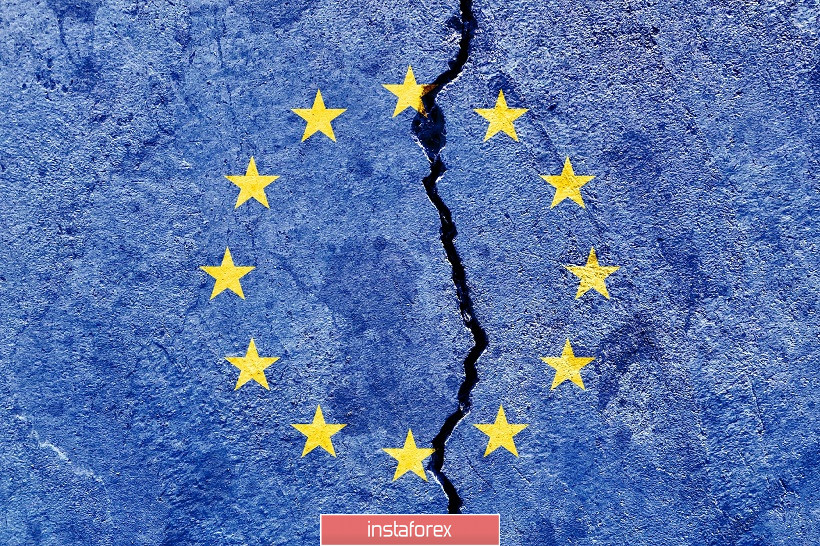The euro-dollar pair continues to show bullish sentiment, despite the unabated political crisis in Europe. The confrontation between Brussels and the so-called "Hungarian-Polish alliance" continues to be on the agenda, exerting background pressure on the euro. But the general weakness of the dollar allows the buyers of EUR/USD to keep the previously occupied price heights: the pair have beset the 19th figure for the third day. Thursday's corrective pullback, which was triggered by the publication of the ECB minutes, was predictable. After two days of recoilless growth, the pair had to adjust for further ascent.
However, it is worth emphasizing that the current growth of the pair is due solely to the weakness of the US dollar, while the euro is under the yoke of its own problems: observe, for example, at the dynamics of such cross-pairs as EUR/JPY or EUR/CHF. This suggests that the prospects for the euro-dollar pair will depend on the condition of the dollar index. If it continues to decline, buyers of EUR/USD will be able to get to the middle of the 19th figure or even test the resistance level of 1.1970. If the attractiveness of the US dollar increases, we expect a decline in the area of the 18th figure that is, to the support levels of 1.1870, 1.1830. The euro is currently unable to contain the blow and repel the possible onset of dollar bulls. The political conflict over the EU budget is to blame.

Let me remind you that Hungary and Poland blocked the final approval of the budget, opposing the new EU rules. According to these rules, Brussels can reduce payments to those countries that violate the principles of the rule of law. Human rights activists have often made similar complaints about Budapest and Warsaw: Hungarians are criticized for pursuing a tough policy against illegal migrants, while poles are criticized for judicial reform and control of the media. In other words, under these circumstances, both Hungary and Poland may not receive tens of billions of euros from EU funds. Therefore, they blocked the budget process, demanding either to exclude the above-mentioned mechanism or to postpone its implementation.
The preliminary negotiations between Brussels and Germany did not lead to anything. Moreover, the Prime Ministers of Hungary and Poland signed an agreement on Thursday, that they will act as a "united front" on this issue. The EU leadership is threatening to use alternative mechanisms for implementing the budget, while some Polish and Hungarian politicians are talking about the possible collapse of the EU. However, the latter argument is exclusively populist: according to preliminary polls, about 70-80% of Hungarians and Poles are in favor of membership in the European Union. After the implementation of Brexit, political parties or movements appeared in almost every EU country that supports the state's withdrawal from the Alliance. But, as a rule, the relevant ideas are lobbied by either marginal or right-wing (right-wing radical) forces that do not enjoy broad electoral support. Therefore, all talk about the conditional "POLEXIT" is nothing more than talk.
Nevertheless, the very fact of a political conflict puts pressure on the euro. Therefore, it is worth repeating that the growth of the EUR/USD pair is due only to the weakness of the dollar.
There are several reasons for the USD to feel insecure. The very common one is the increased market interest in risky assets. The US dollar, which has long been used by the market as a protective tool, has ceased to be in demand. In addition, the devaluation of the greenback is explained by other, more specific factors. First of all, is the coronavirus and its "derivative" problems of a political and economic nature. On Thursday, more than 2,000 people died from Covid-19 in the US, which was the highest death rate in the country over the past six months. The daily morbidity rate does not fall below the 170,000 mark. Governors of many States are forced to tighten quarantine restrictions (up to a complete lockdown), and this fact negatively affects the dynamics of macroeconomic indicators. For example, the number of applications for unemployment benefits has been rising for the second week in a row, foreshadowing weak Nonfarms that will be published next Friday.
Meanwhile, the issue of accepting a new aid package for the US economy has been hanging in the air since the end of October. After nearly 6 months of negotiations, Democrats and Republicans were unable to find a compromise. At the moment, no one knows when the negotiation process will resume, given the change of power in the White house. Most likely, politicians will return to this issue at the beginning of next year.

Thus, the fundamental background, in general, contributes to the further growth of EUR/USD. On Thursday, the pair's bears tried to go for a correction, amid the growth of the US dollar. But the dollar index showed an upward trend for just a few hours, after which it began to slide down again. The euro-dollar pair, respectively, acted in a mirror way: after a decline to the level of 1.1880, it resumed its growth, returning to the area of the 19th figure. All this suggests that the pair retains the potential for further growth, with the first (and so far main) target of 1.1970 being the upper line of the Bollinger Bands indicator on D1.
 English
English 
 Русский
Русский Bahasa Indonesia
Bahasa Indonesia Bahasa Malay
Bahasa Malay ไทย
ไทย Español
Español Deutsch
Deutsch Български
Български Français
Français Tiếng Việt
Tiếng Việt 中文
中文 বাংলা
বাংলা हिन्दी
हिन्दी Čeština
Čeština Українська
Українська Română
Română

